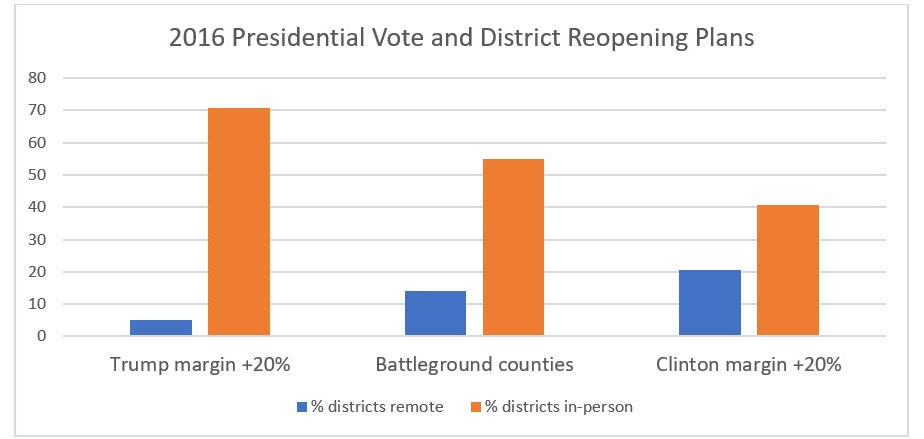Michigan School Reopening Decisions More Related to Partisan Politics than to COVID Threat
Michigan’s Education Policy Innovation Collaborative released a new report tracking Michigan school district decisions about whether to reopen for in-person instruction this Fall. They found 59 percent of districts are providing at least the option of fully in-person education and 12 percent are fully remote only (others are pursuing hybrid strategies).
An initial analysis of large school districts across the country from the Brookings Institution found that district decisions were more related to local politics (summarized by President Donald Trump’s county vote share in 2016) than the local threat of COVID-19 (summarized by July COVID-19 cases in the county).
Similar patterns seem to be evident in Michigan.
Guidelines from the Harvard Global Health Initiative suggest that all but seven counties in Michigan are ready to re-open at least some schools for in-person instruction. But districts in those seven counties are only a bit more likely to be going fully remote (14%) than those in other counties (11%). We took a look at the Michigan COVID-19 data at the county level and found only a limited relationship between COVID-19 severity and re-opening decisions. Districts in counties with higher than average case counts are 1.6 times more likely to go remote; those with below average case  counts are 1.4 times more likely to offer an in-person option.
counts are 1.4 times more likely to offer an in-person option.
The relationship between partisan politics and re-opening decisions is stronger. Among districts in counties where Republican Trump beat Democratic candidate Hillary Clinton by more than 20 percentage points in the two-party vote, only 5% are all remote and 71% are offering in-person instruction. Where Clinton beat Trump by more than 20 percentage points, 21% are all remote and only 41% are offering school in-person. In other words, in heavily Democratic voting counties, school districts are more than four times as likely to open fully remote this fall. In heavily Republican counties, school districts are 1.7 times as likely to offer in-person instruction. School districts in political battleground counties are in the middle.
The relationship between district reopening plans and partisan politics remains strong, even when accounting for COVID-19 severity, recent increases in COVID-19 cases, whether an area is in Phase 5 according to the state, the presence of large universities, or school district enrollment. Presidential vote is more predictive of school district decisions than COVID-19 severity, controlling for all of these factors.
One other political factor is associated with school district decisions: the restrictiveness of collective bargaining agreements (as measured by researchers who analyzed every Michigan school district collective bargaining agreement negotiated in the 2014-15 school year). Some teachers’ unions have been active in calling for remote instruction and they may have been successful. Districts with more restrictive labor agreements were significantly more likely to go all remote and less likely to offer in-person education. Teachers’ unions are typically allied with the Democratic party, so we might expect that unions are part of the reason for the strong relationship between partisanship and reopening plans. However, even when we control for variation in local collective bargaining agreements, the presidential vote remains the strongest factor for predicting reopening plans.
A simple linear model including all of these factors suggests that the chance of moving to remote only instruction rises 6 percentage points for every 10 percentage points more of the two-party vote that Clinton received. And COVID-19 cases are no longer a major predictor of re-opening decisions after accounting for political factors.
Why do we see these patterns, both nationally and here in Michigan? Districts may be following public opinion on reopening, which is increasingly following partisanship. As Trump has called for re-opening schools, Republicans have been supportive of returning to school buildings and Democrats much less so. A recent Washington Post poll found that 69% of Republicans but only 28% of Democrats say it is safe to re-open schools in-person.
Michigan left school reopening decisions to local districts, as did the vast majority of states. But local decisions do not necessarily mean more responsiveness to local public health threats. Many school districts in Michigan are instead following the trends of national-level partisan polarization on school reopening.



